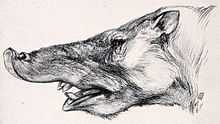Pyrotherium
| Pyrotherium Temporal range: Early Oligocene | |
|---|---|
 | |
| Pyrotherium romeroi and Rhynchippus equinus | |
| Scientific classification | |
| Kingdom: | Animalia |
| Phylum: | Chordata |
| Class: | Mammalia |
| Order: | †Pyrotheria |
| Family: | †Pyrotheriidae |
| Genus: | †Pyrotherium Ameghino, 1888 |
| Species | |
| |
Pyrotherium ('fire beast') is an extinct genus of South American ungulate, of the order Pyrotheria, that lived in what is now Argentina, during the Early Oligocene. It was named "Fire Beast" because the first specimens were excavated from an ancient volcanic ashfall.
The vaguely elephant-like Pyrotherium was 3 m (10 ft) long and 1.50 m (5 ft) tall at the shoulders, with a weight up to 3500 kg (3.85 tons) for P. romeroi. A recently discovered species, P. macfaddeni was smaller, at under 900 kg (1 ton) in weight. [1] The living animal's heavy body was carried by robust legs. Pyrotherium also had a short trunk on its snout, and two pairs of flat, forward-facing tusks in the upper jaw, with a single pair in the lower jaw.[2]

Possible South American descendants of the xenungulates, the complete study of the tarsus of Pyrotherium fails to support this relationship. In one study, derived characters were not seen in any mammal examined except the embrithopod Arsinoitherium from the Cenozoic of Africa.[3] Whether this is due to common ancestry, or to the unusual mode of locomotion used by these animals (graviportal and plantigrade) remains to be seen.
References
- ↑ http://tech.groups.yahoo.com/group/MammalPaleontology/message/332
- ↑ Palmer, D., ed. (1999). The Marshall Illustrated Encyclopedia of Dinosaurs and Prehistoric Animals. London: Marshall Editions. p. 249. ISBN 1-84028-152-9.
- ↑ Shockey, B.J., and Anaya, F. (2004). "Pyrotherium macfaddeni, sp. nov. (late Oligocene, Bolivia) and the pedal morphology of pyrotheres". Journal of Vertebrate Paleontology 24 (2): 481–488. doi:10.1671/2521.